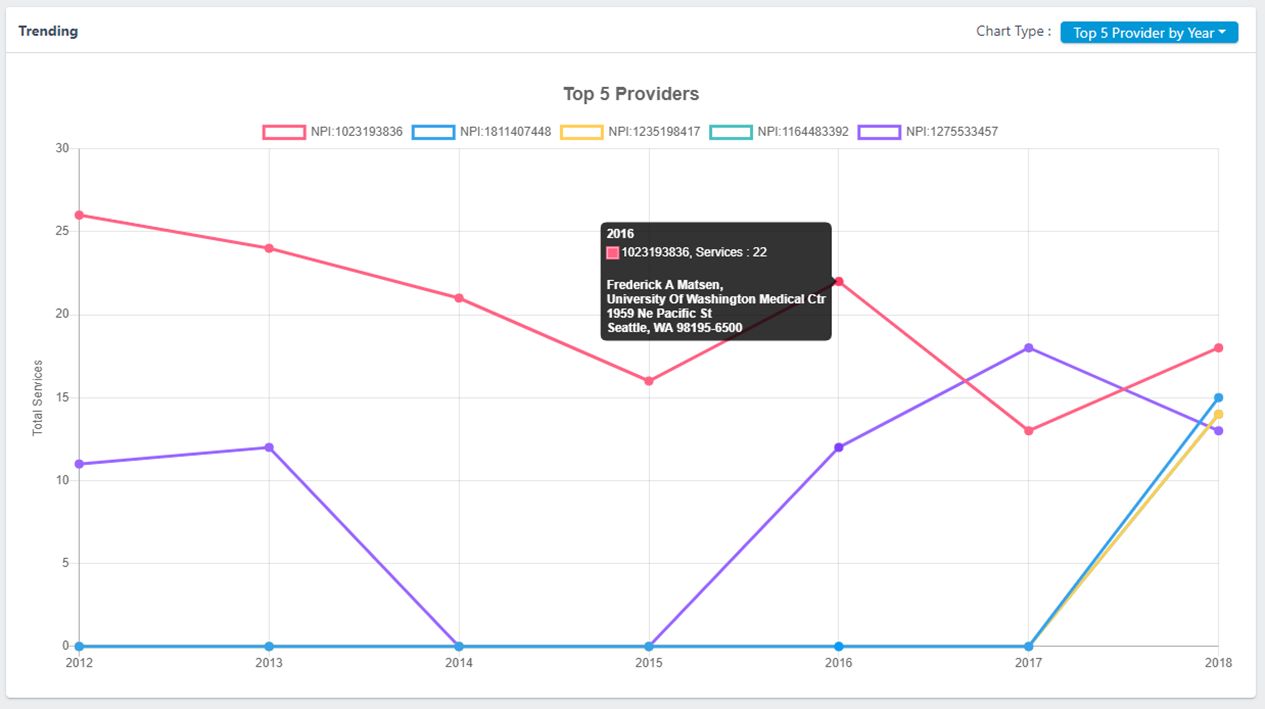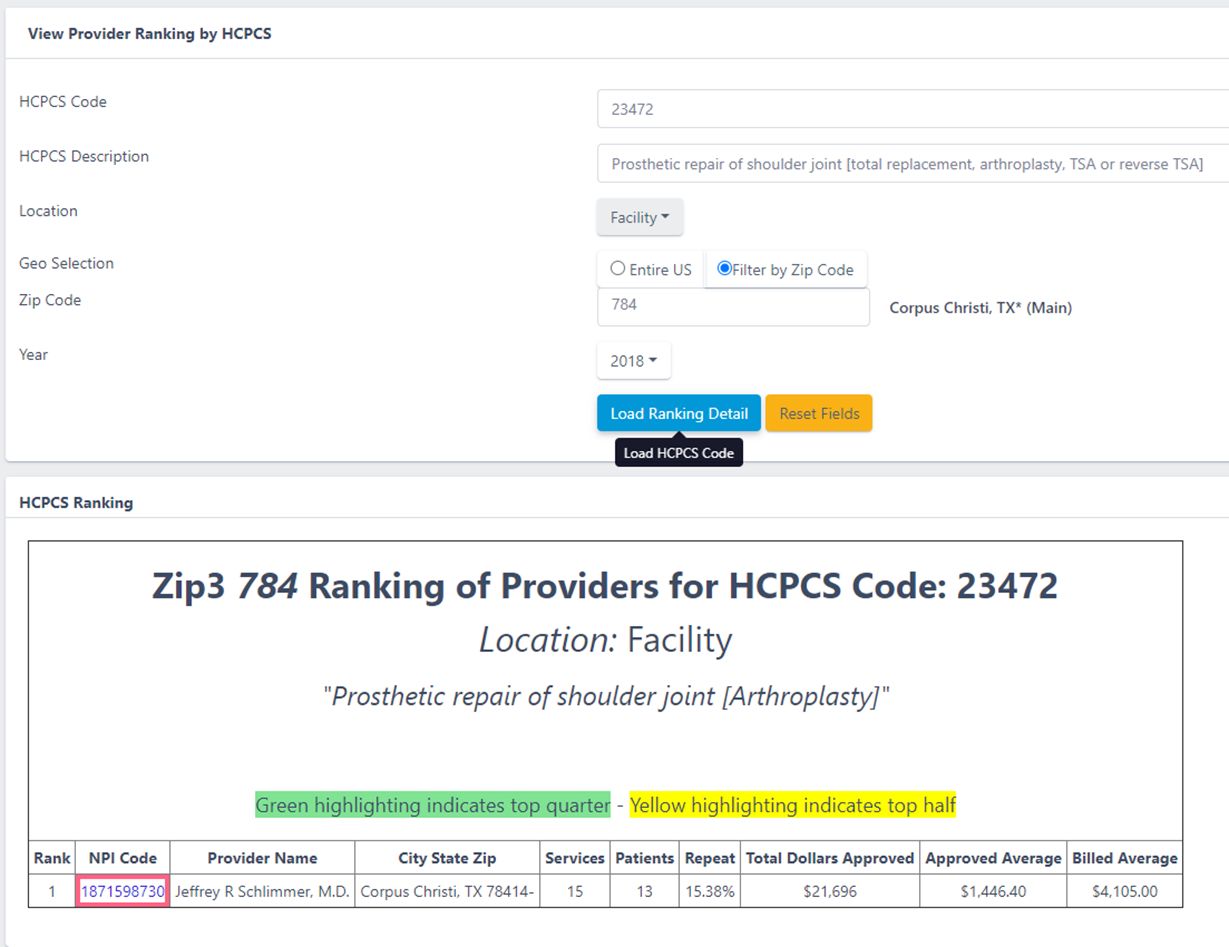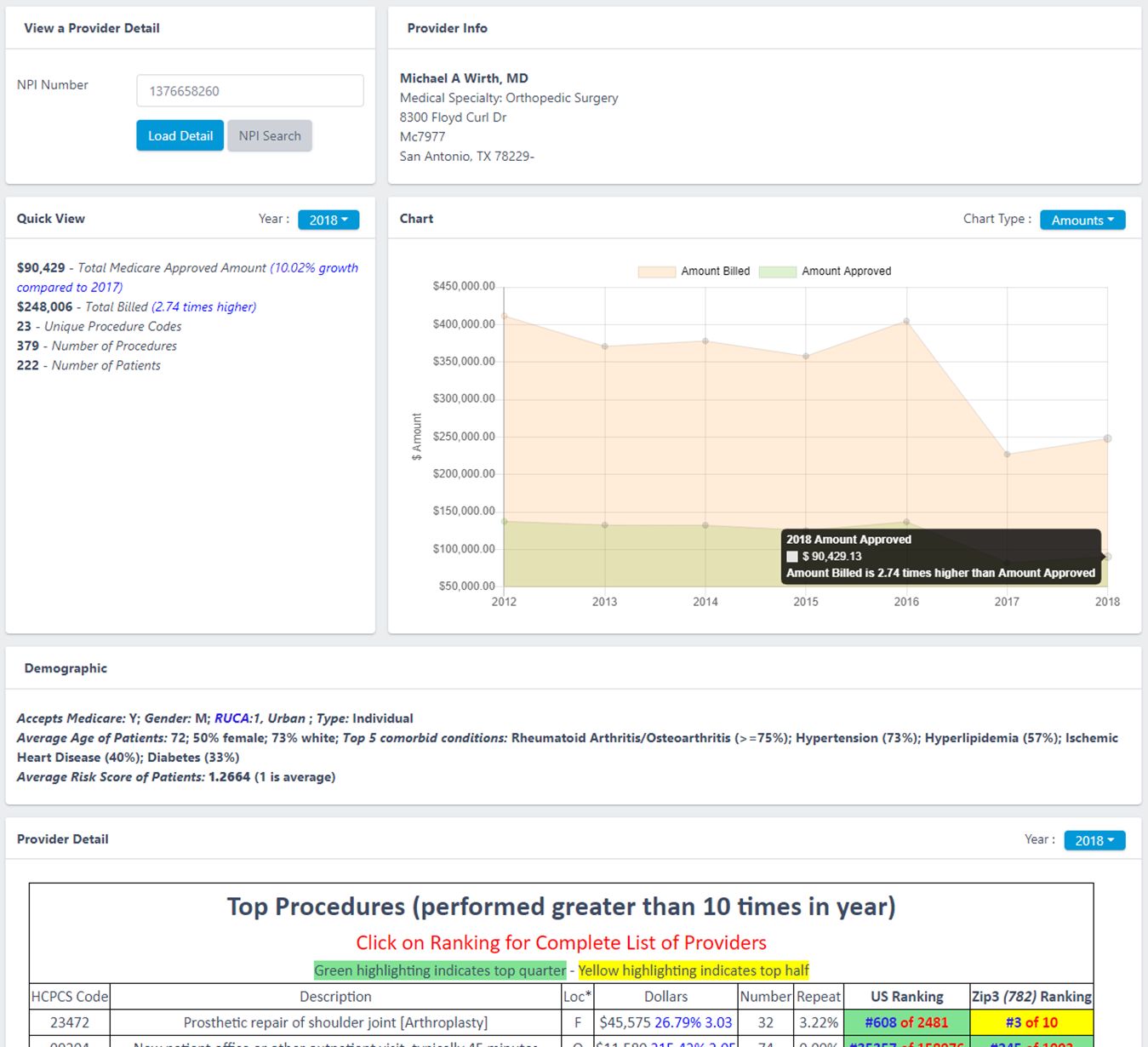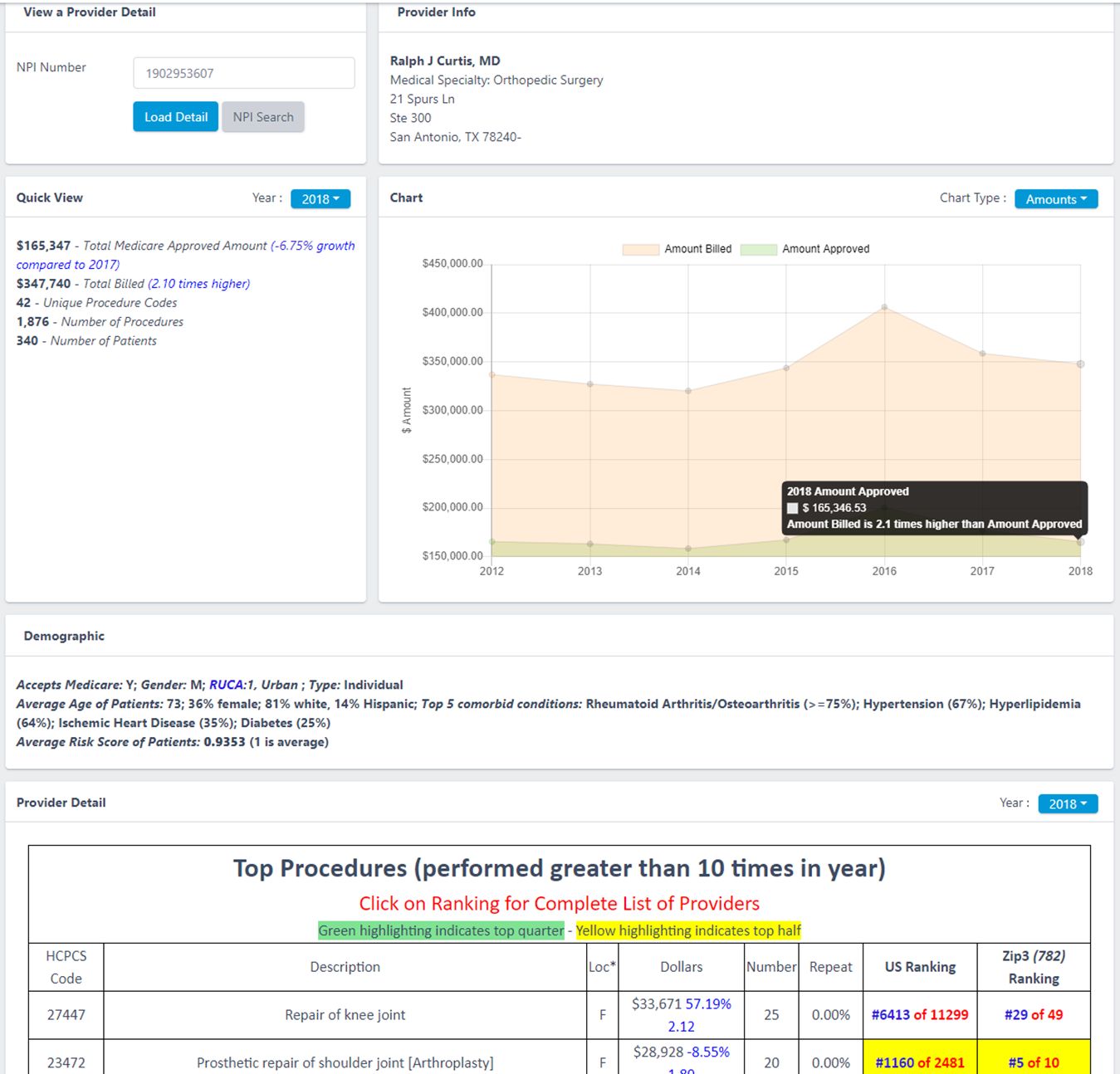
Finding the Right Shoulder Replacement Surgeon, a Case Study in How to Use the Provider Ranking System™ (PRS)
By Phil Denniston, President, Denniston Data Inc.
5/5/21
WHERE TO START
Ideally, we would like to find a local provider. Let us use Corpus Christi, Texas, as an example. This is a medium-sized city, with population of about 500,000 for the greater SMSA (Standard Metropolitan Statistical Area). There are a number of local doctors who promote doing shoulder replacements in the Corpus Christi area. What do we know about these doctors – specifically, are they experienced? This data may be hard to determine accurately, but with Provider Ranking System™ (PRS), we can look this up. There are many ways to search if you do not know the correct HCPCS code (Healthcare Common Procedure Coding System). You can type arthroplasty into the HCPCS description to see the various joint replacements, and then pick shoulder. Below is a copy of the results. This shows there is only one surgeon in the Corpus Christi area who has performed over 10 of these procedures in the latest year, which is the minimum number to qualify to be on the CMS ranking list, as shown below:

Based on this actual data, none of the providers advertising that they do shoulder replacements in Corpus Christi, Texas, are very experienced with this procedure. As another doctor commented, these surgeons are still learning how to do shoulder replacements, and if you were their patient, they would be practicing on you.
NEXT STEP: EXPANDING OUR GEOGRAPHY
To see a more experienced surgeon, we may need to do some travel, and San Antonio is the closest larger city to Corpus Christi. San Antonio is about 2 hours away, and it has a metropolitan area population of over 2.5 million, five times as big as Corpus Christi. Because shoulder replacement is not as common as other joint replacement surgeries, we will look at experience over the entire 7-year period, as shown below:
|
U.S. Ranking of
Providers for HCPCS Code: 23472, "Prosthetic repair of shoulder joint [arthroplasty]" |
|||||||||
|
Rank |
NPI Code |
Provider Name |
City State Zip |
Services |
Patients |
Repeat |
Total Dollars Approved |
Approved Average |
Billed Average |
|
1 |
1376658260 |
Michael Wirth, MD |
San Antonio, TX 78229 |
320 |
312 |
2.56% |
$453,279 |
$1,416.50 |
$4,280.66 |
|
2 |
1902953607 |
Ralph Curtis, MD |
San Antonio, TX 78240 |
124 |
121 |
2.47% |
$176,401 |
$1,422.59 |
$2,740.00 |
|
3 |
1780849372 |
Robert Hartzler, M.D. |
San Antonio, TX 78216 |
118 |
116 |
1.72% |
$165,633 |
$1,403.67 |
$6,857.46 |
Only three doctors have performed over 100 of these procedures over the seven-year period, so only the top 3 are shown above. Michael Wirth, MD, is the leader, and Ralph Curtis, MD, is second. We can use Provider Ranking System™ (PRS) to obtain more detail on each doctor to help us make a final decision. In order to access this information, we can search on a doctor, or, even better, we can just click on their NPI number (National Provider Identifier) in the ranking list. For example, part of each of their summary Provider Detail pages are shown below, first for Michael Wirth:

And for Ralph Curtis

We can learn several things from this further display of the data. First, Dr. Wirth’s practice has been declining in recent years, to a total of about $90,000 approved in the latest year, whereas Dr. Curtis has held steady, with about $165,000 approved in the latest year. As far as the ratio of billed amount to amount approved, Dr. Wirth was 2.74 times higher overall (and 3.03 times just for shoulder arthroplasty), but Dr. Curtis was 2.10 times higher overall (and 2.12 times for shoulder arthroplasty). This may be a consideration if insurance does not fully cover the costs. In addition, Dr. Wirth had a repeat percentage on his shoulder arthroplasties of 3.22% versus 0.00% repeats for Dr. Curtis. Another difference identified is that Dr. Wirth has an Average Risk Score of Patients of 1.2664, where 1 is average, but Dr. Curtis has an Average Risk Score of 0.9353. This means that Dr. Wirth is more likely to treat riskier patients, so if you have complicating comorbidities, you may want to consider this. Also Dr. Curtis’ patients are 36% female, but Dr. Wirth’s are distributed evenly with 50% female. So, Dr. Curtis is more likely to treat male patients.
Sometimes it is helpful to reinforce the objective data from PRS with other information available from services such as Healthgrades, as well as the opinions of local medical professionals and patients. Doing that, we can discover that many patients from Corpus Christi travel to San Antonio to see Dr. Curtis for shoulder arthroplasty, and they are happy with the results, especially given that Dr. Curtis can provide them with a successful home rehab program that will limit the amount of time they need to spend away from home. We can also see that he has been selected as the shoulder doctor for the San Antonio Spurs, professional basketball team, and he has a focus on sports medicine.
CONSIDERING ANOTHER APPROACH
|
U.S. Ranking of
Providers for HCPCS Code: 23470, "Prosthetic repair of shoulder joint [hemiarthroplasty]" |
|||||||||
|
Rank |
NPI Code |
Provider Name |
City State Zip |
Services |
Patients |
Repeat |
Total Dollars Approved |
Approved Average |
Billed Average |
|
1 |
1023193836 |
Frederick Matsen |
Seattle, WA 98195 |
166 |
134 |
23.88% |
$183,552 |
$1,105.73 |
$3,583.18 |
|
2 |
1609836402 |
Timothy Stapleton, MD |
Macon, GA 31210 |
79 |
61 |
29.50% |
$69,963 |
$885.61 |
$3,090.66 |
|
3 |
1275533457 |
Marston Holt, M.D. |
Houston, TX 77058 |
77 |
65 |
18.46% |
$81,311 |
$1,055.99 |
$2,920.26 |
|
4 |
1184677817 |
William Doukas, M.D. |
Bridgeport, WV 26330 |
76 |
54 |
40.74% |
$63,576 |
$836.53 |
$2,156.84 |
|
5 |
1154319226 |
Steven Chamberlain, MD |
Medford, OR 97504 |
71 |
54 |
31.48% |
$60,675 |
$854.58 |
$3,060.63 |
|
6 |
1215923396 |
Samir Guru, D.O. |
Mount Dora, FL 32757 |
54 |
36 |
50.00% |
$46,887 |
$868.27 |
$2,683.35 |
|
7 |
1518034404 |
Matthew Smith, MD |
Columbia, MO 65212 |
54 |
33 |
63.63% |
$38,871 |
$719.83 |
$3,286.04 |
|
8 |
1669428538 |
Jeffrey Visotsky, MD |
Morton Grove, IL 60053 |
51 |
30 |
70.00% |
$42,283 |
$829.08 |
$3,563.35 |
In looking at a graph of the top providers by year, we can see that most of the other top ranking doctors for ream and run, are fairly new to this procedure, but they are growing quickly as they take their lead from Dr. Matsen, the original innovator.

Further research shows that Frederick Matsen, at the University of Washington, has patients from all over the world who come to him for this specialized surgery. He invented it, he does the most, and he has the best outcomes. This is another possibility if we might be candidates for this specialized surgery, and we are willing to sacrifice more difficult rehab for longer and more successful return to function, especially athletic function. And that is in addition traveling to Seattle, Washington, and planning for an overnight stay. This illustrates another benefit of PRS, in that you can identify the top doctors in the entire U.S., and you can consider them if you are willing to do some travel for your medical treatment. And in some cases, you may be able to use telemedicine for evaluation before traveling for the actual surgery.
Denniston Data’s Health Insights from Provider Ranking System™ (PRS) are developed with data from the PRS platform. Want even more insights? In addition to national data, rankings are also available for every local area in the U.S., fer every service provided and reimbursed by Medicare. Start a Free Trial now and get access to the highest quality data and intelligence on healthcare providers. Explore These Claims.
